View in other NatureServe Network Field Guides
NatureServe
Montana
Utah
Wyoming
Idaho
Wisconsin
British Columbia
South Carolina
Yukon
California
New York
Twin Arnica - Arnica sororia
Native Species
Global Rank:
G5
State Rank:
S4S5
C-value:
Agency Status
USFWS:
USFS:
BLM:
External Links
General Description
Stems solitary, 20–40 cm. Herbage glandular, pubescent, sometimes with tufts of white hair among leaf bases. Leaves: basal blades short-petiolate, narrowly lanceolate, entire, 3–10 cm long; cauline 2 to 4 pairs, similar, sessile above. Heads 1 to 5; involucre hemispheric, 10–15 mm high. Rays 9 to 16; ligules 1–2 cm long. Pappus short-barbed, white. Achenes hirsute, 3–7 mm long (
Lesica et al. 2012. Manual of Montana Vascular Plants. BRIT Press. Fort Worth, TX).
Species Range
Montana Range
Range Descriptions
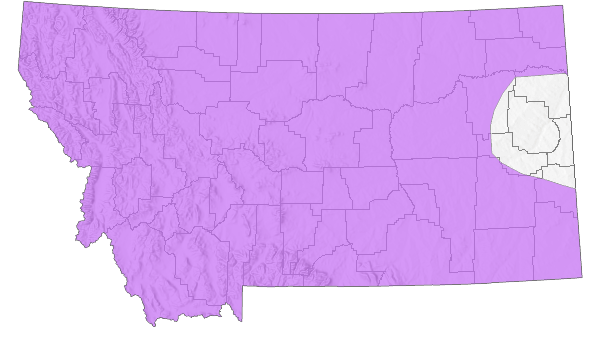
 Native
Native
Range Comments
BC to SK south to CA, NV, UT and WY (Lesica et al. 2012. Manual of Montana Vascular Plants. BRIT Press. Fort Worth, TX).
Observations in Montana Natural Heritage Program Database
Number of Observations: 392
(Click on the following maps and charts to see full sized version)
Map Help and Descriptions
Relative Density
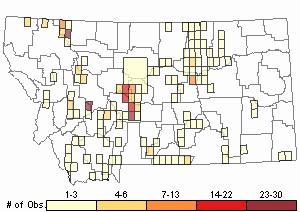
Recency
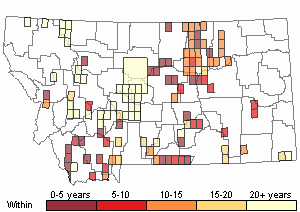

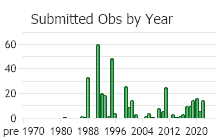
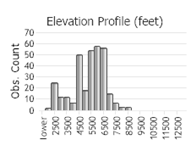 (Observations spanning multiple months or years are excluded from time charts)
(Observations spanning multiple months or years are excluded from time charts)
Habitat
Ecology
POLLINATORS The following animal species have been reported as pollinators of this plant species or its genus where their geographic ranges overlap:
Bombus bifarius,
Bombus mixtus, and
Bombus occidentalis (Mayer et al. 2000, Wilson et al. 2010).
Stewardship Responsibility
References
- Literature Cited AboveLegend:
 View Online Publication
View Online Publication Lesica, P., M.T. Lavin, and P.F. Stickney. 2012. Manual of Montana Vascular Plants. Fort Worth, TX: BRIT Press. viii + 771 p.
Lesica, P., M.T. Lavin, and P.F. Stickney. 2012. Manual of Montana Vascular Plants. Fort Worth, TX: BRIT Press. viii + 771 p. Mayer, D.F., E.R. Miliczky, B.F. Finnigan, and C.A. Johnson. 2000. The bee fauna (Hymenoptera: Apoidea) of southeastern Washington. Journal of the Entomological Society of British Columbia 97: 25-31.
Mayer, D.F., E.R. Miliczky, B.F. Finnigan, and C.A. Johnson. 2000. The bee fauna (Hymenoptera: Apoidea) of southeastern Washington. Journal of the Entomological Society of British Columbia 97: 25-31. Wilson, J.S., L.E. Wilson, L.D. Loftis, and T. Griswold. 2010. The montane bee fauna of north central Washington, USA, with floral associations. Western North American Naturalist 70(2): 198-207.
Wilson, J.S., L.E. Wilson, L.D. Loftis, and T. Griswold. 2010. The montane bee fauna of north central Washington, USA, with floral associations. Western North American Naturalist 70(2): 198-207.
- Additional ReferencesLegend:
 View Online Publication
View Online Publication
Do you know of a citation we're missing? Aradottir, A.L. 1984. Ammonia volatilization from native grasslands and forests of SW Montana. M.Sc. Thesis. Bozeman, MT: Montana State University. 48 p.
Aradottir, A.L. 1984. Ammonia volatilization from native grasslands and forests of SW Montana. M.Sc. Thesis. Bozeman, MT: Montana State University. 48 p. Cope, M.G. 1992. Distribution, habitat selection and survival of transplanted Columbian Sharp-tailed Grouse (Tympanuchus phasianellus columbianus) in the Tobacco Valley, Montana. M.Sc. Thesis. Bozeman, Montana: Montana State University. 60 p.
Cope, M.G. 1992. Distribution, habitat selection and survival of transplanted Columbian Sharp-tailed Grouse (Tympanuchus phasianellus columbianus) in the Tobacco Valley, Montana. M.Sc. Thesis. Bozeman, Montana: Montana State University. 60 p. Culver, D.R. 1994. Floristic analysis of the Centennial Region, Montana. M.Sc. Thesis. Montana State University, Bozeman. 199 pp.
Culver, D.R. 1994. Floristic analysis of the Centennial Region, Montana. M.Sc. Thesis. Montana State University, Bozeman. 199 pp. Durham, R. A., D. L. Mummey, L. Shreading, and P.W. Ramsey. 2017. Phenological patterns differ between exotic and native plants: Field observations from the Sapphire Mountains, Montana. Natural Areas Journal, 37(3), 361–381.
Durham, R. A., D. L. Mummey, L. Shreading, and P.W. Ramsey. 2017. Phenological patterns differ between exotic and native plants: Field observations from the Sapphire Mountains, Montana. Natural Areas Journal, 37(3), 361–381. Grove, A.J. 1998. Effects of Douglas fir establishment in southwestern Montana mountain big sagebrush communities. M. Sc.Thesis. Bozeman, MT: Montana State University. 150 p.
Grove, A.J. 1998. Effects of Douglas fir establishment in southwestern Montana mountain big sagebrush communities. M. Sc.Thesis. Bozeman, MT: Montana State University. 150 p. Hodgson, J.R. 1970. Ecological distribution of Microtus montanus and Microtus pennsylvanicus in an area of geographic sympatry in southwestern Montana. Ph.D. Dissertation. Bozeman, Montana: Montana State University. 65 p.
Hodgson, J.R. 1970. Ecological distribution of Microtus montanus and Microtus pennsylvanicus in an area of geographic sympatry in southwestern Montana. Ph.D. Dissertation. Bozeman, Montana: Montana State University. 65 p. Husby, P.O. 1982. Effects of grazing on vegetation in the Artemisia tridentata-Festuca idahoensis habitat type. M.Sc. Thesis. Bozeman, MT: Montana State University. 76 p.
Husby, P.O. 1982. Effects of grazing on vegetation in the Artemisia tridentata-Festuca idahoensis habitat type. M.Sc. Thesis. Bozeman, MT: Montana State University. 76 p. Johnson, T. W. 1982. An analysis of pack and saddle stock grazing areas in the Bob Marshall Wilderness. M.Sc.Thesis. Bozeman, MT: Montana State University. 105 p.
Johnson, T. W. 1982. An analysis of pack and saddle stock grazing areas in the Bob Marshall Wilderness. M.Sc.Thesis. Bozeman, MT: Montana State University. 105 p. Lesica, P., M.T. Lavin, and P.F. Stickney. 2022. Manual of Montana Vascular Plants, Second Edition. Fort Worth, TX: BRIT Press. viii + 779 p.
Lesica, P., M.T. Lavin, and P.F. Stickney. 2022. Manual of Montana Vascular Plants, Second Edition. Fort Worth, TX: BRIT Press. viii + 779 p. Martinka, R.R. 1970. Structural characteristics and ecological relationships of male blue grouse (Dendragapus obscurus (Say)) territories in southwestern Montana. Ph.D Dissertation. Bozeman, MT: Montana State University. 73 p.
Martinka, R.R. 1970. Structural characteristics and ecological relationships of male blue grouse (Dendragapus obscurus (Say)) territories in southwestern Montana. Ph.D Dissertation. Bozeman, MT: Montana State University. 73 p. Quire, R.L. 2013. The sagebrush steppe of Montana and southeastern Idaho shows evidence of high native plant diversity, stability, and resistance to the detrimental effects of nonnative plant species. M.Sc. Thesis. Bozeman, MT: Montana State University. 124 p.
Quire, R.L. 2013. The sagebrush steppe of Montana and southeastern Idaho shows evidence of high native plant diversity, stability, and resistance to the detrimental effects of nonnative plant species. M.Sc. Thesis. Bozeman, MT: Montana State University. 124 p. Rundquist, V.M. 1973. Avian ecology on stock ponds in two vegetational types in north-central Montana. Ph.D. Dissertation. Bozeman, MT: Montana State University. 112 p.
Rundquist, V.M. 1973. Avian ecology on stock ponds in two vegetational types in north-central Montana. Ph.D. Dissertation. Bozeman, MT: Montana State University. 112 p. Seipel, T.F. 2006. Plant species diversity in the sagebrush steppe of Montana. M.Sc. Thesis. Bozeman, MT: Montana State University. 87 p.
Seipel, T.F. 2006. Plant species diversity in the sagebrush steppe of Montana. M.Sc. Thesis. Bozeman, MT: Montana State University. 87 p. Williams, K.L. 2012. Classification of the grasslands, shrublands, woodlands, forests and alpine vegetation associations of the Custer National Forest portion of the Beartooth Mountains in southcentral Montana. M.Sc. Thesis. Bozeman, MT: Montana State University. 376 p.
Williams, K.L. 2012. Classification of the grasslands, shrublands, woodlands, forests and alpine vegetation associations of the Custer National Forest portion of the Beartooth Mountains in southcentral Montana. M.Sc. Thesis. Bozeman, MT: Montana State University. 376 p.
- Web Search Engines for Articles on "Twin Arnica"





